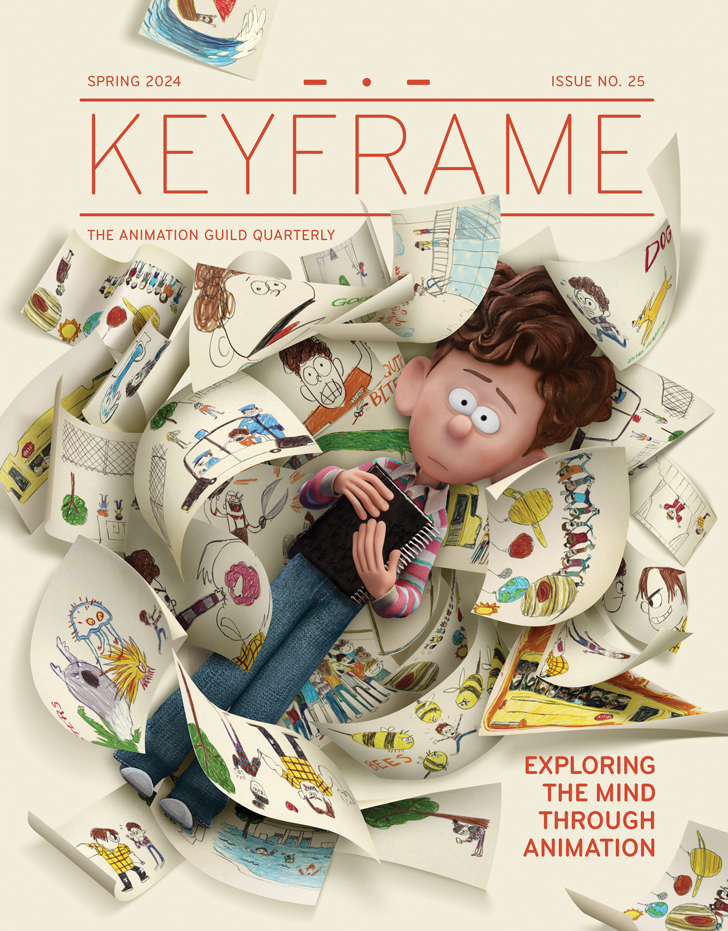
Lorin Z. Pillai
Lead Surfacing Artist, Jurassic World Camp Cretaceous
What drew you to a job as a surfacing artist?
I spent several years as a muralist, and I love color theory and color application. I wanted to have a position where I was part of a team that was creating something bigger than I could create on my own. The collaborative process of creating animation—it’s really incredible the way it unfolds. We have a lot of assets to get through in order to create these final shots, and sometimes it can be a seemingly insurmountable amount of work. Working with other artists to figure out how to approach that is really exciting for me.
How would you describe your job to a layperson?
If [someone was] looking at what a shot would look like without my job, they would see gray scale models moving around. My job is to apply not only color to the surfaces, but also [to figure out] how bumpy are they, how shiny are they, how dull and matte. But it’s not just paint. It’s developing the shaders. It’s how those shaders, which are applied to the gray models, react to light.
It’s equal parts artistic and technical. That was very hard for me at first. I spent two years [at Gnomon School of Visual Effects] learning and pushing my mind to wrap around this crazy CG process. Now I’ve been in the industry for over 12 years, worked at various studios and on games as well, and surfacing has been the aspect I’ve gravitated toward the most because I get to paint.
Describe a challenge you’ve encountered in this job.
I was incredibly challenged to do the raptors for Jurassic World Camp Cretaceous. What are they going to look like? What’s going to make the most sense? They had to feel of the same world from the films, and yet they had to have their own flavor and flair.
We used real life references: different lizards and birds’ legs. But also, it was supposed to be pseudo-real life, because at the end of the day these raptors are in the same shots with these very stylized characters. If you had a realistic-looking dinosaur right next to these human characters, but they’re clearly cartoons, it would feel off.

Candice Stephenson
Look Development Lead, Big Nate
What do you love most about your job?
My first love—before I ever touched a computer, before I ever learned how to animate—was drawing and painting. When I went to school, I went as a generalist. And once I started doing the different parts of the CG pipeline, I found that texturing was something I was really good at. I also liked surfacing because, I joke, it’s kind of like painting with math.
When you build shaders and start dealing with that, all of those terms are physics terms. You have to think both problem-solving—dealing with the way the computer calculates, and the way that light behaves—in addition to understanding painting and color theory and how to make something look beautiful. This is one of the crafts where you really get to have a foot in both left brain and right brain thinking.
What advice do you have for new artists starting this job?
Sometimes in CG you have people who will come at it from a love of the software, a love of technology, which you absolutely need. But it’s also important to go out and do your own research. You might have a program that has a really cool leaf shader, which yes, absolutely, research that. But go outside and look at your own leaves.
It was kind of a joke with my peers at [Nickelodeon]. I love fabrics. So I had this bag of fabrics at my desk because there might be some really cool shaders out there that do fabrics, but I like to physically pick it up and hold it and play with it in the light to see what it does. Don’t be afraid to do your own research, and really look at objects and come up with your own solutions.

Suki Lee
Head of Environments and Set Extension, Us Again
What does your job entail?
I’m in charge of everything [to do with the] environment, from something very small—a mug the character is holding—to the whole set. [This involves] look development, which is texturing and surfacing. But also modeling, set dressing, and set extension, which is matte painting. Everything is all combined together as one environment… texture to finished art.
Do you have a favorite surface you’ve work on?
One of the fun moments I worked on [in Us Again] was the bridge shot. It’s the moment when it goes from dry to wet. So we need to look at how the street or concrete is reacting to different weather, and the time of the day, and when the neon lights or the traffic lights are zooming by, how it reacts differently.

After that, creating the whole city in the background. How the lights are showing in the buildings, when some of the rooms have lights on and some of the rooms don’t have lights on, and how that interacts with the traffic lights. We considered the geometry and the natural qualities of what the materials are. Also, we played with depth of field, boca, and all that stuff. That was really fun, working with animation and effects.
How do you stay up-to-date on tools and technology?
You can’t just be comfortable where you are. Always look out for inspiration from your peers, from other artists, from other studios. Even in our groups, our team members, we show what we’re up to, personal work, what we’re doing. And if there’s new software or anything else, we share and we talk about it. It’s a constant learning process.











.png)